A county hall or shire hall is a common name given to a building that houses the seat of local government for a county.
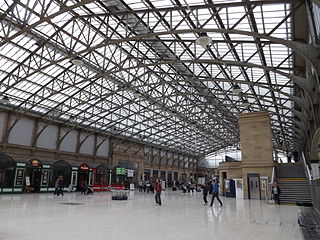
Aberdeen railway station is the main railway station in Aberdeen, Scotland. It is the busiest railway station in Scotland north of the major cities of Glasgow and Edinburgh. It is located on Guild Street in the city centre, next to Union Square.
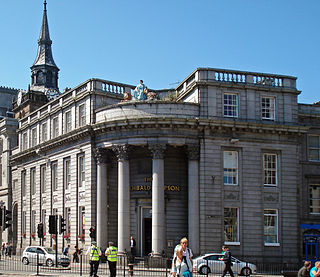
The architecture of Aberdeen, Scotland, is known for the use of granite as the principal construction material. The stone, which has been quarried in and around the city, has given Aberdeen the epithet The Granite City, or more romantically, and less commonly used, the Silver City, after the mica in the stone which sparkles in the sun.
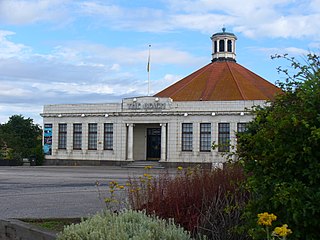
The Beach Ballroom is an art deco building on the beach boulevard of Aberdeen, Scotland. It is home to one of Scotland's finest dance floors – famous for its bounce – which floats on fixed steel springs. It was built in 1926, and is a Category B listed building.
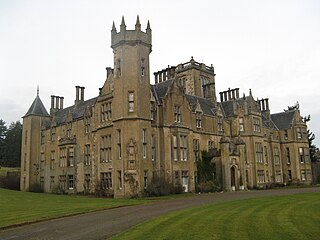
John Smith was a Scottish architect. His career started in 1805 and he was appointed as the official city architect of Aberdeen in 1807, the first person to hold this post. Together with Archibald Simpson, he contributed significantly to the architecture of Aberdeen, and many of the granite buildings that gave the city the nickname 'The Granite City' or also 'The Silver City' are attributed to them.

Union Bridge is a bridge on Union Street, Aberdeen, Scotland. It is the largest single-span granite bridge in the world, at 130 feet. It was built by Thomas Fletcher under some influence from Thomas Telford. It is a Category B listed building with Historic Scotland.

The Triple Kirks in Aberdeen, Scotland were built at the time of the Disruption of 1843 when the Free Church of Scotland split from the Church of Scotland. The three churches were all part of a single building with a tall spire but they housed separate congregations. The East Free Kirk was completed 1843 followed by the West Free Kirk and South Free Kirk early the following year. From about 1966 the building progressively fell into disuse and became mostly ruinous but with the spire remaining.

Robert Gordon Wilson (1844–1931) was a 19th/20th century Scottish architect based in Aberdeen. He was from a strong United Presbyterian background and specialised in churches for the United Presbyterian Church and Free Church of Scotland.

Aberdeen Town House is a municipal facility in Castle Street, Aberdeen, Scotland. The town house, which is the headquarters of Aberdeen City Council, is a Category A listed building.

Inverurie Town Hall is a municipal building in the Market Place in Inverurie, Scotland. The structure, which served as the meeting place of Inverurie Burgh Council, is a Category B listed building.
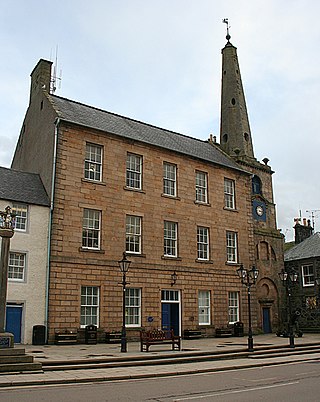
Banff Town House is a municipal building in Low Street, Banff, Aberdeenshire, Scotland. The building, which is used as a customer service point and job centre, forms part of a complex consisting of a steeple, completed in 1767, which is a Category A listed building, and a town house, completed in 1797, which is also a Category A listed building.

Kintore Town House is a municipal structure in The Square, Kintore, Aberdeenshire, Scotland. The structure, which is used as commercial offices, is a Category A listed building.

Stewart's Hall, formerly Huntly Town Hall, is a municipal structure in Gordon Street, Huntly, Aberdeenshire, Scotland. The structure, which is used as a community events venue, is a Category C listed building.
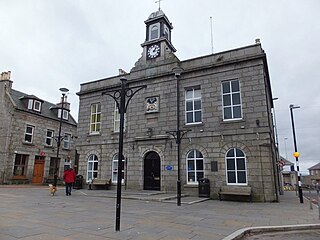
Oldmeldrum Town Hall is a municipal structure in the Market Square, Oldmeldrum, Aberdeenshire, Scotland. The structure, which is used as a community events venue, is a Category B listed building.

The Old Sheriff Court is a former municipal and judicial building in Wilson Street, Glasgow, Scotland. The building, which is home to the Scottish Youth Theatre, is a Category B listed building.

The Justiciary Buildings is a judicial complex in the Saltmarket in Glasgow, Scotland. The complex, which operates in conjunction with similar facilities in Edinburgh and Aberdeen, is dedicated for the use of the High Court of Justiciary, which is the supreme criminal court in Scotland. It is a Category A listed building.
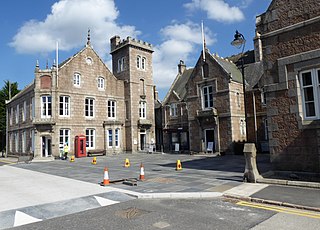
The Victoria and Albert Halls is a complex of municipal buildings in Station Square, Ballater, Aberdeenshire, Scotland. The structure, which accommodates the new Ballater Community and Heritage Hub, is a Category C listed building.

Banff Sheriff Court is a judicial structure in Low Street, Banff, Aberdeenshire, Scotland. The structure, which was the headquarters of Banffshire County Council and was also used as a courthouse, is a Category B listed building.

County Buildings is a municipal structure in Court Street, Haddington, East Lothian, Scotland. The structure, which was the headquarters of East Lothian County Council and was also used as a courthouse, is a Category B listed building.
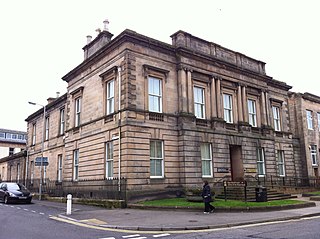
Elgin Sheriff Court is a municipal structure in the High Street, Elgin, Moray, Scotland. The structure, which was the headquarters of Morayshire County Council and remains in use as a courthouse, is a Category B listed building.




















